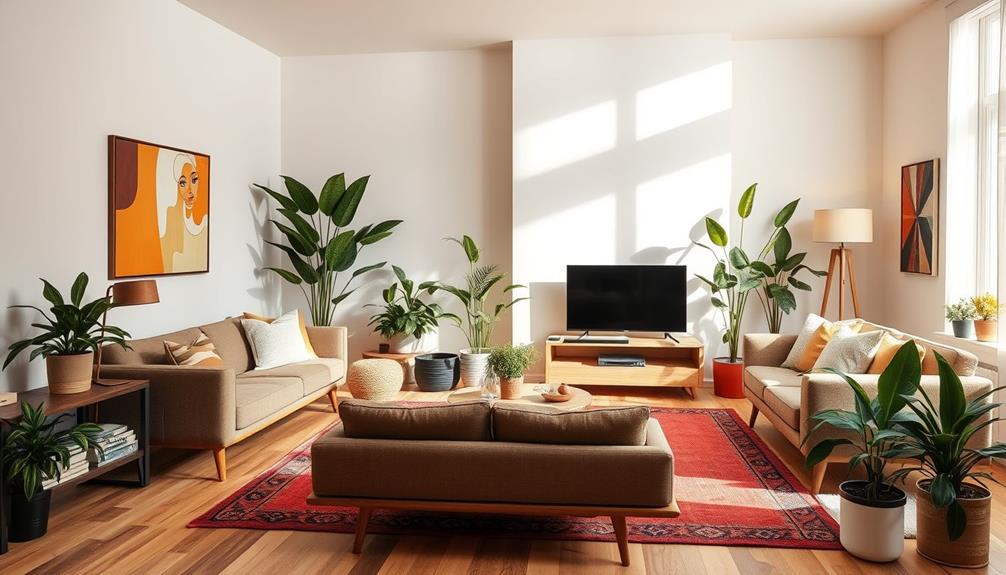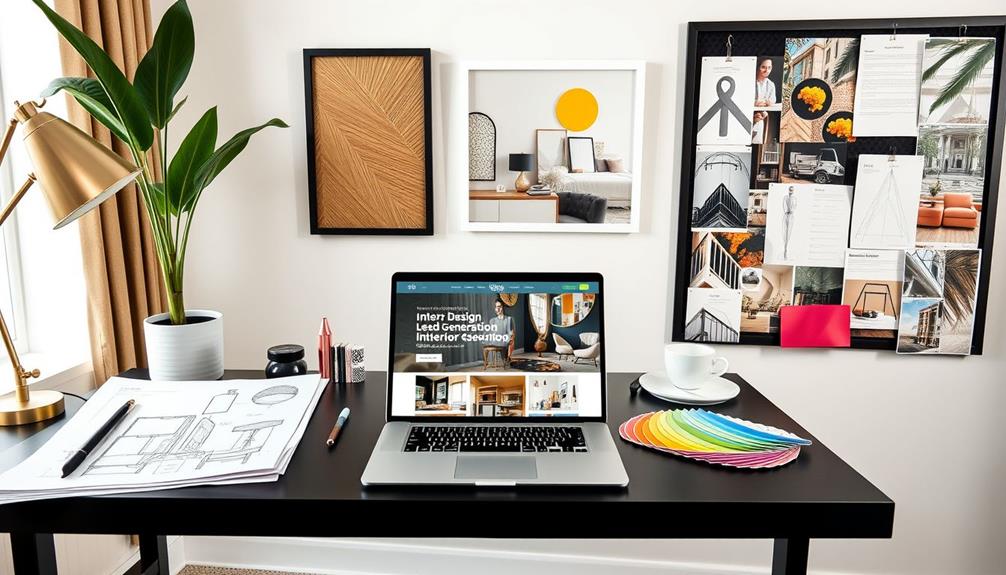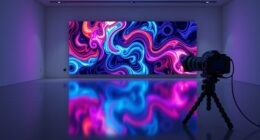You can design a room by starting with a clear budget, categorizing your must-haves, and gathering inspiration from your travels or online platforms like Pinterest. Identify the room's purpose and guarantee good flow by allowing enough space for movement. Choose an anchor piece that draws attention and builds your color palette around it. Select versatile furniture and arrange it thoughtfully to create functional zones. Don't forget about layering lighting for ambiance and including personal touches like art or photographs. There's so much more to explore in designing your dream room!
Key Takeaways
- Establish a budget by categorizing expenses and tracking them in a detailed spreadsheet, including a cushion for unexpected costs.
- Gather design inspiration from diverse sources like travel, art, and online platforms to create mood boards reflecting your personal style.
- Define the room's purpose and evaluate the flow to ensure comfortable movement and functional furniture arrangements.
- Select an anchor element that serves as the focal point of the room, guiding the overall design and furniture choices.
- Incorporate layered lighting and personal touches like photographs and art to enhance the room's ambiance and emotional connection.
Budget and Planning
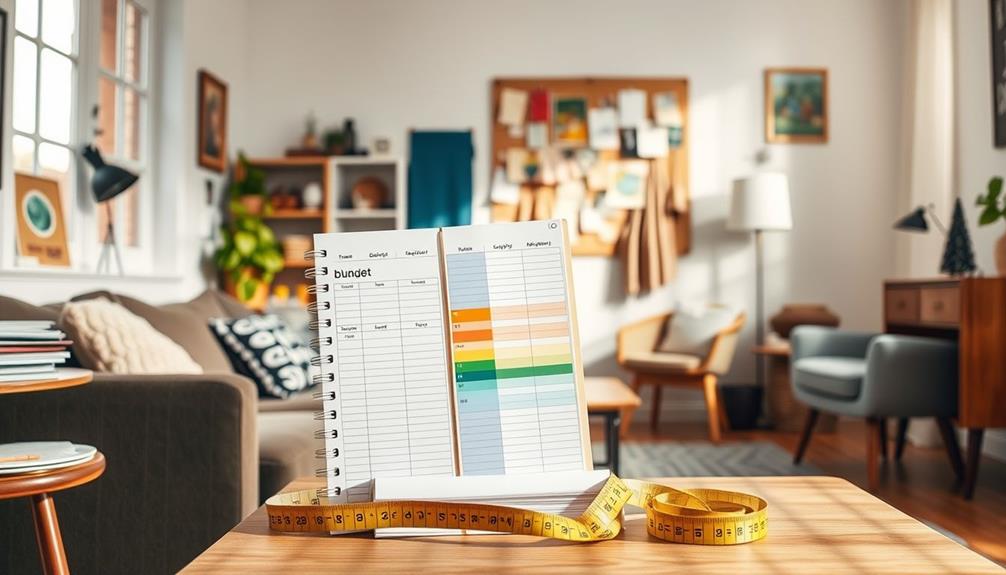
When you're ready to tackle interior design, establishing a budget is your first step. Start by categorizing your expenses into must-haves, nice-to-haves, and non-priorities. This approach helps you maintain control over remodeling costs.
Additionally, consider checking out the importance of flexibility in scheduling when planning your project timeline. Create a detailed spreadsheet to track all project expenses, including a cushion of 10-20% for unexpected costs that may pop up during the process.
Before you purchase furniture, make certain you take accurate measurements of your space. Use tools like graph paper or digital floor planner apps to visualize your furniture placement effectively. This will aid in proper space planning and guarantee your design flows well.
It's also wise to obtain at least three bids from contractors to compare costs and quality. This way, you can select the best option for your home improvement project.
As you go along, periodically review total costs to guarantee you stay within financial limits while allowing for any adjustments that accommodate your evolving tastes. Remember, a well-planned budget is essential for a successful interior design journey.
Gather Design Inspiration

To gather design inspiration, start by exploring diverse sources that spark your creativity.
Use platforms like Pinterest to collect images and ideas that resonate with your style, making it easier to visualize your vision.
Don't forget to check out local art galleries and unique spaces for fresh perspectives that can elevate your room's design.
Explore Diverse Sources
MY ARTICLE SUBHEADING CONTENT]:
Often, the most intriguing design ideas come from unexpected places, so it's crucial to explore a variety of sources for inspiration. When you're designing a room, consider gathering ideas from diverse experiences and environments.
For instance, breathtaking destinations can influence color schemes and textures that evoke feelings of adventure and luxury. Here are some suggestions to kickstart your creativity:
- Travel Experiences: Whether it's a beach resort or a bustling city, different cultures unleash unique design elements that can inspire your home decor.
- Local Art: Visit galleries or local artists' studios to discover colors and styles that resonate with you, providing a personal touch to your decorating ideas.
- Restaurants and Hotels: Observe how these spaces effectively use color, texture, and layout. You might find practical ideas for creating a room that feels inviting and stylish.
- Design Magazines and Online Resources: Stay updated with current trends and innovative materials. This will help you explore fresh approaches that can enhance your interior design.
Utilize Visual Platforms
Visual platforms are invaluable for gathering design inspiration, as they allow you to curate ideas that truly resonate with your personal style. Start by using Pinterest to create mood boards filled with images that speak to you. As you collect these visuals, you'll begin to identify common themes and color palettes that can guide your design choices.
Explore design-specific websites and social media accounts to discover a diverse range of design ideas from both professionals and enthusiasts. This can broaden your perspective and spark creativity.
Don't forget to engage with platforms that offer virtual room design tools, letting you experiment with different layouts and color palettes before making any purchases.
Follow home decor blogs and online magazines that showcase successful room transformations. These sources provide practical tips and fresh ideas that you can easily apply to your own space.
Define Room Purpose

To create a functional and inviting space, you need to identify the primary purpose of the room.
Think about how you and your guests will use the area, as this will shape your furniture choices and layout.
Identify Room Functionality
Determining the room's primary function is essential for effective interior design. Identifying the purpose of the space guides your design decisions, ensuring it meets your needs and enhances its functionality.
Here are four key considerations to help you define the room's functionality:
- Activities: Think about what activities will take place. A family room requires comfortable seating and a layout that encourages socializing, while a home office needs efficient workspaces and storage.
- Flow: Evaluate how people will move through the space. A well-planned layout accommodates movement and accessibility, ensuring comfortable interaction without clutter.
- Target Audience: Consider who'll use the room. If it's for entertaining guests, aim for a polished and cohesive design. For a personal retreat, feel free to embrace eclectic styles.
- Zoning: In multi-functional spaces, create designated zones with furniture arrangement and area rugs. This clearly defines different uses, enhancing usability while maintaining an appealing room feel.
Focusing on these elements will help you create a well-designed space that reflects its intended functionality.
Consider User Experience
User experience plays an essential role in defining a room's purpose, as it directly influences how individuals interact with the space. Start by clearly defining the primary function of the room—whether it's for relaxation, work, entertainment, or a mix of these. This clarity will guide your design decisions effectively.
Consider incorporating stylish elements like wall clocks to enhance time management visually and create an extraordinary atmosphere.
Next, consider incorporating multi-functional furniture to maximize usability. For instance, a dining table that doubles as a workspace allows for various activities without overwhelming the space.
Establish designated zones within the room using rugs or strategic furniture arrangements. These zones promote organized functionality, making it easier for users to shift between activities.
Don't forget to assess the needs of all potential users, including family members or guests. By creating an inclusive environment, you'll enhance the overall user experience.
Lastly, while flow and accessibility are crucial, focus on how the layout supports interactions and activities. Confirm that furniture placement allows for easy movement, making the space more inviting and functional.
When you prioritize user experience, the room will serve its purpose seamlessly and cater to everyone who enjoys it.
Assess Flow and Accessibility
Understanding how the room will be used is fundamental in evaluating flow and accessibility. By defining the room's purpose—be it a gathering space, home office, or tranquil retreat—you can make informed design choices that enhance usability.
Here are some key aspects to take into account:
- Evaluate Movement: Confirm there are at least 36-48 inches of walkways to promote easy navigation throughout the space.
- Create Zones: Use rugs or strategic furniture arrangements to establish distinct areas for various activities, especially in multi-functional rooms.
- Furniture Placement: Align your furniture pieces with the room's purpose. For instance, arrange seating to foster conversation and enhance accessibility.
- Prioritize Accessibility: Choose furniture heights and layouts that accommodate diverse needs, confirming everyone can comfortably use the space.
Select an Anchor Element

Selecting an anchor element is vital for establishing a cohesive design in your room. This anchor piece serves as the focal point, influencing the overall design direction and the color palette you choose. Think of something you love, like a standout piece of furniture, artwork, or decor that resonates with you personally.
By selecting a beloved anchor piece early in the design process, you simplify your decisions regarding complementary colors, styles, and accessories that align with its aesthetic.
It's important to take into account the size and visual weight of your anchor element, making sure it's proportionate to the room to maintain balance and avoid overwhelming the space.
Once you have your anchor piece in place, it sets the tone for the entire room, guiding your choices of furniture and accessories.
As you think about the color palette, remember it should either complement or contrast with your anchor element. Use a color wheel to guarantee harmonious combinations that enhance the mood of the space.
With a clear focal point, your design process becomes smoother, making it easier to create a room that feels both intentional and inviting.
Choose a Color Palette

Choosing a color palette is essential for creating a harmonious and inviting atmosphere in your room. Start by establishing a cohesive color palette with three to five complementary shades. This foundation will guide your overall design and mood.
Here's how to choose the perfect palette:
- Use the Color Wheel: Explore the color wheel to find shades that complement each other and enhance the room's vibe.
- Choose Neutral Wall Colors: Consider neutral wall colors that allow you to easily integrate bold accessories and furniture without repainting.
- Test Paint Samples: Always test paint samples in different lighting conditions. Colors can look vastly different in natural and artificial light, affecting your overall look.
- Select a Springboard Object: Incorporate a favorite piece of art or a unique rug as a springboard for your color choices. This guarantees your palette resonates with your personal style.
Furniture Selection and Arrangement

Furniture selection and arrangement play an essential role in defining the functionality and aesthetic of your room. Start by prioritizing key furniture pieces like a comfortable sofa and a stylish coffee table, focusing on quality and practicality. This foundation will set the tone for the entire layout.
Consider incorporating elements from modern farmhouse decor trends to create a cozy and inviting atmosphere with neutral color palettes and natural materials.
To guarantee everything fits well, use painter's tape or measuring tools to visualize where your furniture will go. Maintain appropriate spacing—aim for 36-48 inches for walkways and 18 inches between your sofa and coffee table. This helps in creating a seamless flow and easy movement throughout the space.
Choose versatile, neutral furniture that can adapt as your style evolves. Avoid oversized items that could overwhelm smaller rooms and disrupt the overall flow. Research the scale of your furniture in relation to the room size, assuring larger pieces fit comfortably without blocking access.
Lastly, create functional zones within your room using rugs or thoughtful furniture arrangement. This multi-purpose layout not only enhances usability but also adds to the room's aesthetic appeal, making it a welcoming space for you and your guests.
Lighting Design

Effective lighting design can transform your room, creating an inviting atmosphere and enhancing its functionality. To achieve this, you should adopt a layered approach that combines different types of lighting. For instance, incorporating cozy teenage girl room colors can complement your lighting choices, adding depth to the overall design.
Here are some key elements to contemplate:
- Ambient Lighting: Aim for about 20 lumens per square foot to guarantee even brightness without glare. This serves as the foundation of your lighting scheme.
- Task Lighting: Focus on areas where you perform detailed activities, like reading or cooking. Provide between 50 to 100 lumens per square foot to illuminate these spots effectively.
- Dimmer Switches: Incorporating dimmer switches allows you to adjust brightness levels easily. You can create a versatile atmosphere, shifting from bright and energetic to soft and relaxing.
- Color Temperatures: Use a mix of warm (2700-3000K) and cool (3500-4100K) light. Warm light fosters a cozy feel, while cool light enhances alertness and clarity.
Decorate With Personal Touches

Your room should reflect your personality and experiences, turning it into a space that truly feels like home. Start by incorporating personal photographs and memorabilia, creating a narrative that fosters emotional connections. These items not only tell your story but also make the room uniquely yours.
To enhance the functional and aesthetic aspects of your space, consider integrating tailored solutions that cater to your unique needs, as professional services can provide valuable insights tailored solutions for unique needs.
Next, choose art pieces that resonate with your experiences. Whether they come from local artists, your travels, or family creations, these artworks add character and individuality to your space.
Don't forget about textiles; custom-made throw pillows or cozy blankets can enhance both visual appeal and comfort, making the room inviting.
Select decor items that highlight your hobbies or interests. A bookshelf filled with your favorite reads or a display of collectibles speaks volumes about your personality.
Consider Trends and Resources
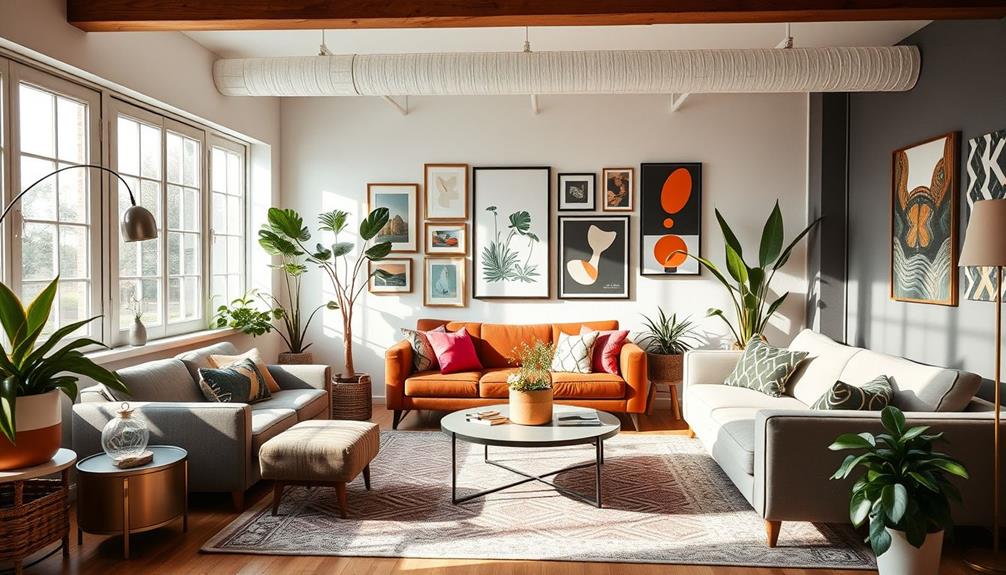
Incorporating personal touches into your room is just the beginning of creating a space that resonates with you. To elevate your design further, consider current trends and useful resources that can shape your vision. Here are some key aspects to keep in mind:
1. Stay Informed: Follow design blogs and social media influencers to keep up with evolving trends, such as sustainable materials and multifunctional furniture.
Embracing a cottagecore aesthetic can bring a serene and cozy vibe to your space, blending rustic charm with productivity.
2. Utilize Online Platforms: Websites like Pinterest and design magazines are treasure troves for fresh design ideas, helping you visualize a cohesive, on-trend interior.
3. Engage Locally: Attend local art events and cultural exhibitions. They can inspire unique elements that reflect your personal style and community influences.
4. Adapt and Innovate: Use insights from design professionals to adapt trends in a way that feels authentic to your space.
Conclusion
By following these steps, you can transform any room into a space that reflects your style and meets your needs. Remember, it's all about making choices that resonate with you and your lifestyle. So, what's stopping you from turning your vision into reality? Embrace your creativity, trust your instincts, and enjoy the process of designing a room that feels uniquely yours. After all, your home should be a true reflection of who you are! Consider starting by creating an interior design mood board to gather inspiration and visualize the elements you want to incorporate into the room. This can help you stay focused and ensure that the final design reflects your personal taste and style. By taking the time to plan and make thoughtful decisions, you can create a space that not only looks great but also feels like home.
